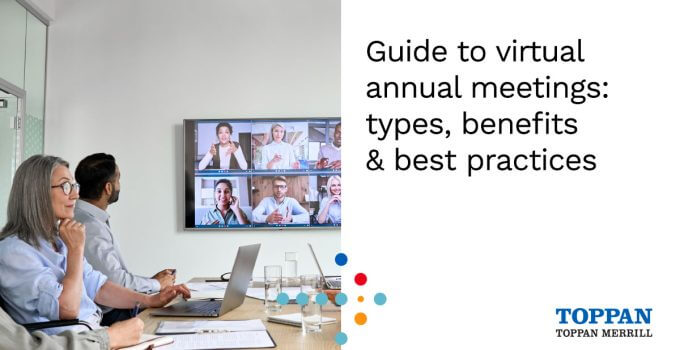In 2019, roughly 300 companies held virtual annual meetings. That number shot up to nearly 2,500 companies in 2020. Fast forward to 2022, 68% of public companies held a virtual shareholder meeting.
Virtual annual meeting preparation
Companies of all types should ensure they are prepared to host a fully virtual or hybrid shareholder meeting. Here is everything you should know in order to begin making your preparations:
What are virtual annual meetings?
A virtual annual meeting uses a virtual platform that enables shareholders to attend and participate remotely, including asking questions and casting votes.
What are the types of virtual annual meetings?
- In-person with live internet streaming: This is the most traditional type of virtual option for annual shareholder meetings. The in-person meeting includes a live internet stream that allows remote attendees to listen (and sometimes watch). Access to this livestream does not require identity verification, and for this reason, remote attendees are not counted toward a quorum and are typically not allowed to ask questions. Because of the limited ability for remote attendees to participate in the meeting, this traditional option is rapidly falling out of favor. Shareholders have grown familiar with remote/virtual meeting platforms, and increasingly expect to be able to not just attend, but meaningfully engage and participate in the virtual annual meeting.
- Virtual-only meeting: This type of virtual annual meeting takes place entirely virtually — there is no option for shareholders to attend in person. Most virtual annual meeting platforms offer remote attendees the option to verify their identity or attend anonymously as a guest. Those attending as unverified guests do not count towards a quorum and are not allowed to vote or examine the list of registered shareholders. Most companies also only allow verified shareholders to ask questions during the Q&A session.
- Hybrid meeting: This type gives shareholders the option to attend virtually/remotely or in person. Because the virtual portion is facilitated through a dedicated virtual annual meeting platform (as opposed to a simple livestream), virtual attendees have the ability to verify their identities — thus allowing them to count toward a quorum, vote, and ask questions during the meeting.
Why is adoption of virtual annual meetings surging?
The COVID-19 pandemic forced thousands of companies to rapidly shift to a virtual annual meeting format for 2020. But several factors have been pushing more organizations to consider virtual or hybrid meeting options for several years now. The costs and logistical burdens of hosting an in-person meeting continue to rise. The growing focus on Environmental, Social and Governance (ESG) values has put a spotlight on the environmental impacts of shareholders traveling to in-person meetings. And, even prior to the pandemic, health and safety concerns created impediments to in-person attendance for many shareholders. Moreover, as shareholders have grown more accustomed to virtual/remote options for conducting everyday business, they’ve pushed for the convenience of a virtual annual meeting format.
Just about every U.S. state now permits some form of virtual annual meeting — virtual-only and/or hybrid. In the wake of the pandemic, several states issued emergency guidance that expanded allowances for virtual annual meeting options. Many states are now considering making these temporary orders permanent.
What are the benefits of virtual annual meetings?
Adding a virtual annual meeting option has a multitude of benefits for both a company and its shareholders:
- Increased shareholder participation/attendance and engagement: Hosting the annual meeting remotely also can make it easier for more shareholders to attend, helping to accommodate health and safety concerns and regulations, potential travel restrictions, etc. A virtual option is often also simply more convenient for shareholders with busy schedules. This helps to increase attendance and participation in the annual shareholder meeting.
- Supporting your commitment to shareholder transparency: Taking steps to promote maximum attendance and engagement demonstrates a strong commitment to shareholder transparency. A virtual annual meeting option shows that your company is proactively delivering important information to all shareholders — and empowering them to make their voices heard, without the barriers of in-person attendance.
- Reduce internal costs and burdens: Virtual annual meetings — particularly virtual-only formats — can significantly reduce the internal costs associated with the event. In addition, the simplified logistics will free up internal staff resources, including requiring much less of a time commitment from executives.
Overcoming challenges: what is required for a virtual annual shareholder meeting?
As with any technology-powered change, the move to a virtual annual meeting option is not without its challenges and risks. From an internal operations/logistics standpoint, these challenges will almost surely be fewer than the logistical challenges of scheduling and hosting an in-person meeting. However, more concerningly, companies must be aware of common issues that shareholders have with a virtual format, including:
- Access and verification: We’ve all experienced the frustration of being “locked out” of a Zoom call or other virtual meeting. Shareholders using a virtual annual meeting platform for the first time (or the tenth time) can experience issues accessing and verifying their identity as a registered shareholder.
- Question submissions: Shareholders have expressed frustration over requirements that questions be submitted before the meeting. There have also been transparency concerns in situations where shareholders were not able to see all submitted questions and felt companies may have selectively chosen/avoided questions to steer the conversation in ways they couldn’t have with an in-person format.
- Shareholder proposal presentations: Some companies have chosen to put limitations on — or what shareholders viewed as excessive barriers to — shareholders presenting their proposals.
Best practices for virtual annual meetings
Companies and their shareholders learned a lot about the good and bad of holding virtual annual meetings through the crash-course of 2020. Some basic best practices have since emerged, including the following:
- Solicit shareholder input: Before making a decision on meeting format, solicit feedback from shareholders about different types of meeting formals (e.g., in-person, virtual-only, hybrid). Make sure to consider input from both institutional and personal investors.
- Consider voting: Consider how a virtual-only or hybrid meeting will support (or impede) discussions around items that will be voted on at the meeting.
- Ensure equal access: Make sure all shareholders, as well as any other expected guests, have equal access to attend and participate in the meeting.
- Prepare for maximum volume: Ensure your company’s virtual annual meeting platform/technology can support the maximum possible number of meeting attendees and the maximum potential volume of engagement and participation (i.e., discussion among many attendees). Make sure live technical support is readily available before, during and after the meeting.
- Include visual elements: To capture the shareholder engagement opportunity, include visual elements to support the audio component for remote attendees. If possible, consider adding live video of board members to further engage remote attendees.
- Prepare and rehearse: Just as with in-person meetings, preparing scripts, reviewing potential shareholder questions, syncing with general counsels and audit partners on shareholder proposals, and even running full rehearsals for executives and directors can help ensure a smooth experience on the big day.
- Formalize the rules of engagement: Just as there are rules that govern engagement and proceedings for an in-person shareholder meeting, you should have formal rules to govern virtual meetings — such as how discussion will be facilitated among attendees, and how questions will be queued.
- Set clear expectations for Q&A: Clearly define the process and any deadline for submitting questions for the Q&A period of the meeting. Define guidelines and time limits on topics of questioning in order to keep the meeting moving forward and establish a process for answering questions submitted during the meeting.
- Gather suggestions for improvements: Following the meeting, again solicit shareholder feedback on any concerns and ideas for how the meeting could be improved.
- Provide on-demand access: Ensure the full audio/video of the meeting is clearly posted and easily accessible for on-demand access after the meeting has ended.
In addition to these best practices, the Rutgers Center for Corporate Law & Governance published a report at the end of 2020 with key findings on both successful and problematic practices in virtual shareholder meetings.
Other opportunities for virtual meetings
As more companies become comfortable with — and see the benefits of — virtual annual meetings, many are looking to move other shareholder engagement to a virtual or hybrid format. The typical company holds a variety of shareholder meetings and events throughout the year — to discuss matters such as ESG (Environmental, Social and Governance) proposition, corporate governance and other issues around ongoing operations. Just as with virtual annual meetings, shifting these meetings to virtual or hybrid formats can help increase shareholder engagement while reducing the cost and administrative burden compared to a traditional in-person meeting.
The importance of planning ahead
Many companies were forced to make a very sudden and very unplanned shift to virtual annual meetings in 2020 — and most made this shift quite successfully, given the circumstances and timeline. But between ongoing public health and travel concerns, and the increasingly clear shareholder engagement and cost benefits of virtual shareholder meetings, all companies should proactively make preparations so they can be ready to hold a virtual or hybrid annual meeting. Moreover, shareholders’ expectations are rising rapidly and their patience for technical hiccups and paint points will be dwindling. Companies that cannot provide the convenience of a virtual attendance option — and that cannot deliver a seamless, engaging experience to remote attendees — will increasingly be viewed as behind the times and risk falling behind in terms of shareholder engagement and reputation among investors.
Engaging with a virtual annual meeting partner
Even with all their promise and benefits, virtual annual meetings are undoubtedly a challenging new frontier for most companies. Fortunately, companies don’t have to take on this challenge on their own. Forward-thinking companies are leaning on trusted partners to help them navigate the complexities — from choosing between virtual-only or hybrid, to creating policies for virtual meeting conduct, to selecting the right technology platform for hosting the virtual meeting. Toppan Merrill has helped organize, structure, and facilitate hundreds of successful virtual annual meetings. Our partnerships connect companies to best-in-class technology platforms for hosting virtual annual meetings. And our experienced team provides trusted guidance and expertise at every step of the way, to help companies capture the full benefits of a virtual option, while minimizing the burden on internal resources.
The Toppan Merrill Advantage
Enables convenience and removes expense for management and shareholders
Toppan Merrill can help you dramatically reduce the costs associated with an in-person meeting, including travel for shareholders and the company’s directors and management. This allows shareholders more time to attend a greater number of meetings and minimizes the amount of time that directors and management must spend at meetings.
Drives sophisticated shareholder engagement and promotes your brand
We’ll help you build a virtual annual meeting solution that enables you to manage the entire annual meeting from a single dashboard, monitor real-time voting and efficiently communicate your company’s forward-thinking corporate governance strategy with branded meeting materials, shareholder Q&A features and meeting playback files for your company’s website.
Leverages expert consultation expertise to deliver greater value
Toppan Merrill experts gain a comprehensive understanding of your current annual meeting and proxy process, then identify best practices and peer-group trends from initial concept to annual meeting planning and cost-effective delivery of shareholder communications materials.
An End-to-End Solution
Throughout the entire annual meeting and proxy statement production process, Toppan Merrill facilitates the annual meeting planning, document formatting, drafting, SEC filing, printing and distribution including timeline, process, and budget management. In addition, you are always backed by Toppan Merrill’s nearly 50+ years of expertise in annual meeting and proxy production management.
Virtual shareholder meetings are an increasingly important — and necessary — component of shareholder engagement strategies. Toppan Merrill helps companies organize, structure and facilitate successful fully virtual and hybrid annual meetings, providing expert guidance and connecting companies with best-in-class technology platforms for hosting virtual annual meetings. We can help you deliver seamless shareholder experiences that maximize shareholder engagement, while minimizing your internal burden and costs.
Ready to discuss your virtual annual meeting with one of our experts? Contact us today!


